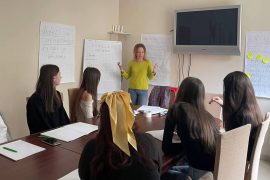
The problem concerns the ambitious plans of the Transcarpathian regional authorities to build 360 mini hydroelectric power stations with dozens of reservoirs at the top of the Carpathian rivers, one third of which should be located on the territory of general nature reserve. To this end, the Transcarpathian Regional Council adopted a decision No. 161 of 25.02. 2011, “On the Program of Integrated Use of Water Resources of the Transcarpathian Region” and Decision No. 310 of 04.11.2011, “On Local and Regional Schemes of the Location of Small Hydropower Plants in the Territory of the Transcarpathian Region.” According to environmentalists and hydrologists, this project could result in an environmental disaster. It is a complete change of the hydrological regime in the Carpathian rivers, complete loss of most of the red book species of animals and plants associated with mountain streams, irreversible change of landscapes, decrease in tourist attractiveness of the region, and the threat of loss of cultural identity of the Carpathians.
With pristine landscapes and traditional mountain management, increased flood processes and catastrophic floods (according to the State Agency’s certificate, only 45 sites are scientifically sound mini HESiv to all Ukrainian Carpathians, and Transcarpathia – within an integrated scheme protyvopavodkovoho protection in the Tisza basin – only 3 mini hydroelectric).
The construction of 360 mini hydropower plants in the upper rivers were not foreseen by the Transcarpathian Regional Development Strategy until 2015. It was developed with the participation of the public and approved in 2006 by the Transcarpathian Regional Council, which contradicts one of the strategic priorities of the region’s development – Spatial harmony and environmental protection.
Meanwhile, 3 mini hydropower plants have already been built and put into operation in Transcarpathia, only one of which has been approved by the relevant state environmental and water and fisheries management services. On the rivers where these hydropower plants are built, today there is a serious loss of stocks of authentic species of fish – brook trout and grayling European, which is also included in the Red Book of Ukraine. None of the projects were publicly discussed, as was the corresponding decision of the Transcarpathian Regional Council. The uncontrolled construction of small hydropower plants has been linked to green tariff action since 2009 and, in our view, to speculation on land issues. Investors do not agree to rebuild existing mini-hydropower plants, but rather destroyed mini-hydropower plants. They are asking for location in the newest and most beautiful area, unspent plots to date. They are also asking for 3-4 times larger area than required for the construction and maintenance of mini hydroelectric plants.
The project is aimed at shaping democratic societal decision-making procedures regarding environmental security through a large-scale civilian representation campaign in Transcarpathia, “STOP mass construction of mini hydroelectric power plants in the upper Carpathian mountains.” These are powerful decisions to build high-risk sites, involve the public in discussing these decisions, and comply with applicable law and basic citizens’ rights to a safe living environment when making such decisions.
Project area: Transcarpathian region.
Objective: To suspend the deployment of small hydropower projects in Transcarpathia at the grassroots level by conducting a civic representation campaign before evaluating them in terms of the potential environmental, landscape, and socio-economic impacts.
Objective 1. Through the use of advocacy tools (informing communities, holding public hearings, dialogue with authorities at round tables and media campaigns) and democratic decision-making procedures to suspend the illegal construction of small hydropower plants in the upper Carpathian mountains.
Objective 2. To develop and agree with all stakeholders the criteria for the allocation of no-go areas to minimize the negative impact of small hydropower on the nature of the Carpathians and minimize the socio-economic impact on local communities.
Task:
- Gathering and preparation of information on the activities of public authorities and management, specialized state structures in the field of water and fisheries management, as well as private investors in preparation of project documentation for the construction of mini hydroelectric power plants in the Transcarpathian region.
- Preparation and printing of leaflets on the negative environmental and socio-economic consequences of the chaotic development of small hydropower in the Carpathians.
- Target trips to settlements where project documentation is being prepared for construction of mini hydroelectric power stations, for consultation and participation in public hearings.
- Conducting an information campaign for the population of the region on the progress and results of the project through publications in the regional press, online publications and TV.
- Video and photo capture of environmental impacts of construction and operation of mini hydroelectric plants on mountain rivers.
- Preparation and holding of a round table with the participation of all stakeholders regarding the adoption of the category “no go areas” where the construction of mini hydropower plants is prohibited.
- Writing and publishing an electronic version of the book “Advocacy Campaign” STOP Mass Construction of Mini Hydroelectric Power Plants in the Upper Carpathian Mountains! “
Partners of the project: Ministry of Foreign Affairs of the Czech Republic, Crimean Human Rights Center “Diya” (Simferopol).
Performance monitoring: The advocacy campaign is in its 9th year. During this time in Transcarpathia, the opinion of local communities on the principles of construction of hydroelectric power plants in the Carpathians has changed, as well as the criteria under which such construction is possible. The opinion on fatal consequences for river ecosystems and low socio-economic effect of small hydropower development in Ukraine was formed, which is supported exclusively by state subsidies in the form of “green tariff”. Therefore, during this time, only 5 SHPPs from the planned 360 SHPPs were constructed, as well as the reconstruction of SHIPIT-2 SHPP where the fish-boat was built.
In 2014, within the framework of the Ecological Rescue Forum of Transcarpathia, the Principles and Criteria for Selection of Sites for the Construction of Hydroelectric Power Plants in the Carpathians were developed. In 2009, in cooperation with the National Ecological Center of Ukraine, the brochure, “Ecosystem Services of the Ukrainian Carpathian Rivers” was published. At the national level, within the framework of the work of the Ukrainian Climate Network in 2019, the Sustainability Criteria for RES Industrial Facilities have been developed and are being promoted in the Ukrainian legislation.







